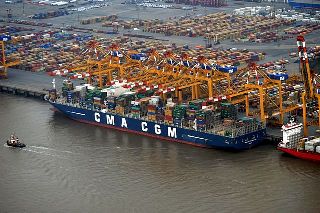 French ocean box liner CMA CGM nearly tripled its net income to US$201 million in the third quarter from $70 million in the same quarter of 2013, as volumes increased to its highest level in the group’s history, although revenue per container fell.
French ocean box liner CMA CGM nearly tripled its net income to US$201 million in the third quarter from $70 million in the same quarter of 2013, as volumes increased to its highest level in the group’s history, although revenue per container fell.
Consolidated revenue amounted to $4.4 billion, a 6.4% increase year-over-year, while core EBIT (earnings before interest and taxes) dropped to $248 million from $271 million for an 8.6 slide.
In a statement, the world’s third largest shipping company attributed the profit improvement to steady growth in the Asia-Europe trade, expansion of its service offering and opening up of new land corridors in Africa, and a robust business in the reefer transport segment.
Volumes transported increased by 8.3% to 3.2 million twenty-foot-equivalent units (TEUs), although average revenue per TEU decreased by 1.8% over the period.
“Carried volumes have reached their highest level over the Group’s history thanks to the lines deployed in high-growth areas and to the strength of the services offered on the main markets,” said the company.
CMA CGM also continued to implement operational cost control that brought down operating costs per TEU slightly and reduced bunker consumption per TEU by 3.4 % versus the third quarter of 2013.
Moreover, it modified in 2013 the bulbous bows of its fleet to improve vessel design to speeds ideal for slow-steaming to realize further fuel and CO2 emission cost savings.
Over the first nine months 2014, group turnover amounted to $12.5 billion, a 4.3% increase over the same period in 2013. The carried volumes totaled 9.1 million TEUs for a 7.4% increase. The core operating margin was stable at $638 million over the first nine months of 2014.
This year, the company received delivery of the CMA CGM Elbe in October and CMA CGM Danube during the second quarter, vessels belonging to a series of twenty-eight 9,400-TEU vessels designed to adapt to the widening of the Panama canal. Four other vessels of this size are expected to be delivered by the end of this year. The group will also take delivery of six vessels with a capacity of 18,000 TEUs in 2015.
Looking forward, the company expects the operating environment in the fourth quarter of the year “to be characterized by the usual seasonal volumes slowdown, freight rates volatility and lower bunker price,” but added that its volume growth “should nevertheless exceed that of the market as a whole.”
Ocean Three launch set for early next year
On its Ocean Three alliance with China Shipping Container Lines and United Arab Shipping Company, the launch is expected to push through in early 2015, with the U.S. Federal Maritime Commission, the only regulatory authority that needs to clear the cooperation, having given its permission.
The agreement, announced in early September. will pool the three carriers’ fleet of 162 vessels for deployment on the Asia-Europe, Asia-Mediterranean, trans-Pacific, and Asia-U.S. East Coast routes.
Asia-East Africa service split into two
Meanwhile, the carrier announced improvements to its Asia-East Africa (ASEA) service by launching it this month as two separate services, ASEA Kenya and ASEA Tanzania.
The move is seen to provide shorter transit times to Kenya and Tanzania, improve the offer to Somalia with weekly calls from the previous bi-weekly country call, cover the Indian Ocean with bi-weekly calls in the Maldives and Seychelles islands, and connect Asia to the following African landlocked countries: Uganda, Congo, Zimbabwe, Zambia, Burundi, Malawi, Rwanda, and South Sudan.
ASEA Kenya will provide a four-day transit time to Kenya on the following rotation: Singapore, Tanjung Pelepas, Port Klang, Colombo, Mombasa, Colombo,and Singapore.
ASEA Tanzania will provide an eight-day transit time to Tanzania on the following rotation: Singapore, Tanjung Pelepas, Port Klang, Colombo, Male, Port Victoria, Dar Es Salam, Colombo, and Singapore.
A 2,800-TEU vessel fleet, which the company said will be the largest capacity vessels in the area, will be deployed on the two services.
Photo: Ailura




